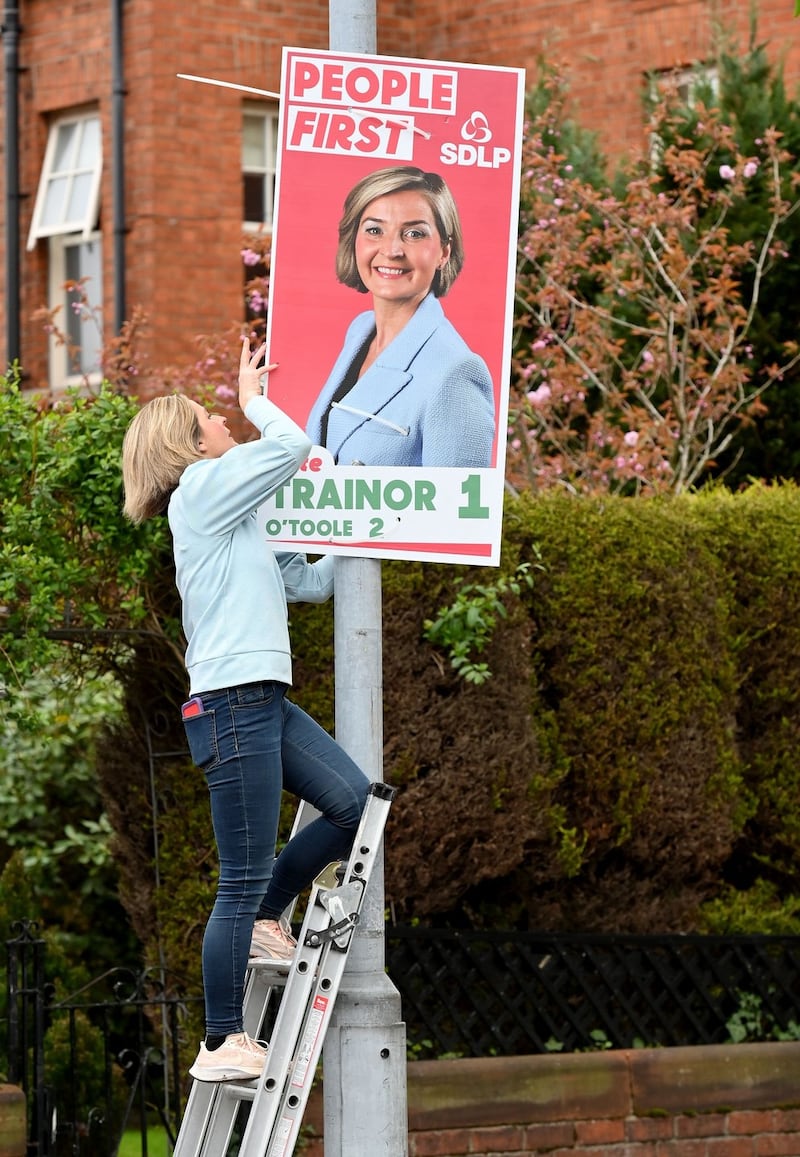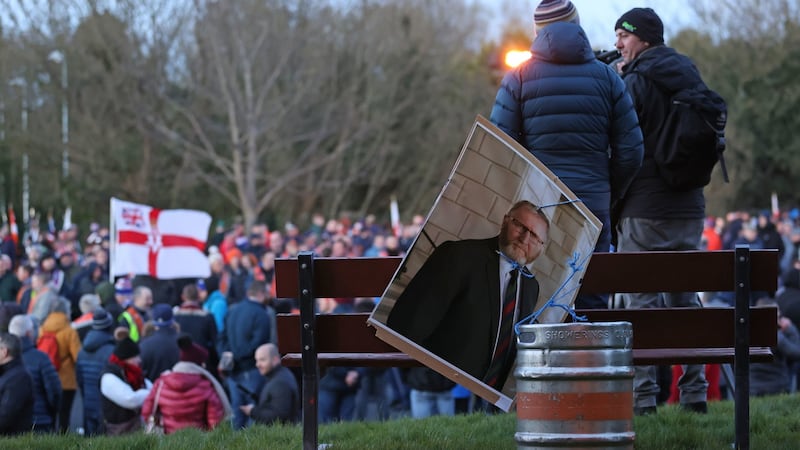With fewer than three weeks to go until polling day, there is at least one point on which Sinn Féin and the DUP agree.
The Northern Ireland Assembly election on May 5th is "the most important election in a generation", said Sinn Féin vice president Michelle O'Neill at the party's election launch event in the Europa Hotel in Belfast; from the back of a lorry at an anti-protocol protest in Ballymoney, Co Antrim, the DUP leader Jeffrey Donaldson told the crowd: "It is the most important election in a generation and will decide the future direction of Northern Ireland. "
Notwithstanding the cynics who point out that, in Northern Ireland, most elections are billed in such a manner, it is clear this time much is at stake.
May 5th could prove a watershed moment; if the polls are correct, Sinn Féin appears poised to return the largest number of Assembly members (MLAs) to Stormont following the election, a victory which would bring with it the position of first minister and, for the first time in its history, put a nationalist at the head of government in the North.
"This is the first time Sinn Féin has been in with a serious shout of capturing the top prize and I think that is making unionists fearful," says Jon Tonge, professor of politics at the University of Liverpool.

Never mind that this is a joint office, and that no nationalist first minister can hold power without a unionist deputy first minister, or vice versa; the symbolism alone would shake the foundations of an already uncertain unionism while giving a great boost to Sinn Féin’s ambitions for leadership on both sides of the Border and, ultimately, for Irish unity.
Hence the recent warning from Donaldson that following through on the polls' predictions of a Sinn Féin taoiseach and first minister would result in "Michelle O'Neill and Mary Lou McDonald touring around London, Brussels and Washington pushing a radical all-Ireland agenda".
“Jeffrey Donaldson’s made clear that stopping Sinn Féin helps stop a Border poll so he’s framed it in those terms already, so there’s a lot at stake on the [Northern Ireland] protocol and a lot at stake on the constitutional future of Northern Ireland,” says Tonge.
As it stands, it appears unlikely there will even be a sitting Assembly after the election; Donaldson has made clear his party will not go back into the Executive while outstanding issues around the Northern Ireland protocol remain unresolved, and he has repeatedly declined to confirm if the DUP would sit as deputy first minister to Sinn Féin’s first minister.
Election posters burned
This would mean talks with an initial deadline of six months; with the can thus kicked a good distance down the road, where, one wonders, would this leave the people of Northern Ireland who, the polls say, consistently prioritise health and education over the protocol or a Border poll?
Indeed, according to the most recent polling in the North – carried out by the Institute of Irish Studies at the University of Liverpool and the Irish News and published last week – only 30 per cent would vote for a united Ireland tomorrow and 33.4 per cent in 10-15 years’ time; on the protocol, more than 70 per cent of unionists either agreed or strongly agreed that Executive parties should jointly seek mitigations and easements from the European Union.
Yet the reality in the North is that however much parties frame their campaigns around bread-and-butter alternatives, an election tends to focus the mind on the constitutional question, particularly in times of heightened tension.
The current climate certainly qualifies. In the five years since the last Assembly election Brexit has become a reality, and so too has the Northern Ireland protocol and unionist and loyalist opposition to it; this has created new fracture lines and deepened existing divisions both within unionism and between it and the anti-Brexit parties, and put the conversation about constitutional change firmly on the agenda.
The hijacking and hoax bomb attack by the UVF on a peace event at which Minister for Foreign Affairs Simon Coveney was due to give a speech recently marked an escalation in loyalist opposition to the protocol, which up until then had largely been voiced in anti-protocol rallies on Friday nights in loyalist heartlands.
That this has already proved a tense campaign demonstrates what is at stake. Election posters have been burned – at the most recent count the PSNI was investigating 41 reports of the removal, damage or destruction of posters – and candidates have been threatened.

In south Belfast, SDLP candidate Elsie Trainor was assaulted and subjected to sectarian abuse after she chased youths removing her posters; her party colleague Paul Doherty was threatened and told he “wasn’t welcome” in a loyalist part of west Belfast.
In Portadown, a brick was thrown at the window of the UUP leader Doug Beattie's constituency office after he announced his party would not take part in anti-protocol rallies; last week, an election poster of Beattie with a noose drawn around his neck was displayed at a rally last Friday.
Traditional allegiances
As the election nears, appeals to traditional allegiances will only strengthen, not least the call to vote DUP as the only party that can save the union and avoid a Sinn Féin first minister or a Border poll; conversely, the refusal by the DUP to say if it would serve as deputy first minister to a Sinn Féin first minister will draw votes – or at least transfers – from other nationalists angry at the apparent double standards. “It’s one step off ‘won’t have a Catholic about the place’,” said one commentator.
At the polls, Sinn Féin has a clear lead. Last week’s poll put Sinn Féin on 27 per cent and the DUP on 20; an average of the last six months’ worth of polling by the same organisations and by LucidTalk and the Belfast Telegraph has the split as 25 per cent to 19.
Compare this to the most recent benchmark, the last Assembly election in 2017, which took place amid its own tensions following the collapse of Stormont, the “cash for ash” scandal and anger over the then first minister Arlene Foster’s “crocodile” comment about nationalists.
Then increased turnout, primarily among non-unionist voters, took Sinn Féin to within a hair’s breadth of the first minister’s position, with 27.9 per cent of the first-preference vote and 27 seats to the DUP’s 28.1 per cent and 28 seats.
If the polls are correct, Sinn Féin has largely held its 2017 position while the DUP has slipped. One of the big questions on results night will be: by how much – or, with more than two weeks still to go, can that lost ground be regained?
The DUP of course contests these figures, arguing that polls have been wrong in the past. Tonge makes the point that the DUP is “quite well dug in . . . they’re half a quota over where they need to be at the moment in terms of a lot of seats that they’re defending so Sinn Féin’s lead in the polls exaggerates the security of Sinn Féin’s position”.
Candidates
Nevertheless their reduced number of candidates – 30 – is reflective of realism about the party’s situation; Sinn Féin by contrast is running 34, its greatest number ever, and is aiming to both hold its 27 seats and potentially pick up a few more, and build a base in other constituencies for the next election.
“If the polls are right and the DUP come in at 19 or 20 per cent, then the DUP would be set to suffer a good number of losses, they would lose about six or seven seats,” says David McCann, deputy editor of the Northern Ireland political website Slugger O’Toole. “If the polls are wrong and they lose maybe about 3 or 4 per cent of their vote then the losses will be more limited.
“The other question is how much of Sinn Féin’s vote holds up, so do they come in around 27 per cent . . . that would bring SF roughly back what they have in terms of seats.”
Tonge predicts “it will be close. I don’t think Sinn Féin will romp home with loads of seats to spare, because I don’t see where Sinn Féin are going to make lots of gains, and I don’t see where the DUP are going to sustain huge losses . . . the winner is going to stagger across the finish line, it’ll be a case of who loses the most.”
As always in a proportional representation election, transfers will be crucial; again according to the University of Liverpool/Irish News poll, half of DUP first-preference voters will transfer to the UUP, and 21.2 per cent to the Traditional Unionist Voice (TUV); those parties will return the favour to a lesser extent, with UUP voters preferring to transfer to Alliance (31 per cent) or TUV (22 per cent) ahead of the DUP.
While the SDLP appear likely to benefit from Sinn Féin transfers – half of Sinn Féin voters polled said they would transfer to the SDLP – the SDLP faithful were less likely to do so, preferring to transfer to Alliance over Sinn Féin.

Most transfer friendly
The SDLP and the UUP have made their pitch as middle-ground alternatives and, in Beattie’s case, effectively staking his political career and the survival of his party on offering a liberal unionist alternative to the DUP; boycotting the anti-protocol rallies attended by other unionist leaders was a significant distancing move and one that may or may not pay off.
Though Sinn Féin and the DUP appear on course to remain as the two largest parties, it is these alternatives, not least Alliance, that will limit potential gains and inflict potential losses.
Alliance is now firmly established as the third largest party and the most transfer friendly, with 46.9 per cent of Greens, 43.4 per cent of SDLP, 31 per cent of UUP and 13.4 per cent of Sinn Féin voters indicating they would transfer to Alliance.
Its breakthrough is potentially the most significant trend to emerge since 2017; back then, it took 9 per cent of first-preference votes, winning eight seats, but in three successive elections in 2019 – European, council and Westminster – it took 18.5, 11.5 and almost 17 per cent respectively, and last week’s poll has it on just under 15 per cent.
As for the election, the party is justifiably confident, expecting to break into double figures; exactly how well it does will be another of the performances to watch on results day.
For Alliance, the ideal scenario would be for it to return sufficient MLAs for it to make the argument for a reset of the structures of government themselves.
Rather than a binary system built around balance between largest unionist and the largest nationalist party, a strong showing for Alliance would bolster its call for a new system that would represent the increasing numbers voting for parties designated as “other” – Alliance, the Greens and People Before Profit, who in the latest poll are on a combined first-preference vote of 21 per cent.
Figures from the Liverpool/Irish News poll show an increasing desire for Assembly reform. More than 50 per cent agreed the requirement for MLAs to designate as nationalist, unionist or other should be removed, and that the titles of first and deputy first minister should be renamed joint first ministers.
‘Worst crisis’
That Stormont is facing into another period of stasis post-election only bolsters that argument for change. While in that same poll there is a clear preference for parties to accept the outcome of the election and form an Executive, there is also support for other options. Two-thirds said their first preference was for direct rule (under varying conditions) if an Assembly is not formed; there was little backing for a period of (potentially lengthy) negotiation.
"I think it's the worst crisis for the institutions since those early post-Good Friday Agreement days . . . this is the first what I would call peacetime monster crisis," says Tonge. "There's very few rabbits that Brandon Lewis can pull out of the hat here to get power-sharing back.
“There’s no positive case now for power-sharing within unionism that is being articulated because it’s all about collapsing the institutions as a threat to move on the protocol.”
In his book Political Purgatory, which covered the collapse of Stormont in 2017 and the efforts that led to its restoration three years later, journalist Brian Rowan wrote in 2020 that "this really should be Stormont's last chance. If it failed again, then it should fail forever."
As Northern Ireland prepares to head to the polls, he sees the “crisis” as coming after the election.
“The next conversation is not back from the Good Friday Agreement, it’s beyond it,” he says. “If Sinn Féin emerges as the largest party, are unionists capable of nominating a deputy first minister to Sinn Féin [as first minister]? I’m not sure they are, and that’s the point where you really are half a step away from its endgame . . . and we’re into the next big conversation about this place.
“While unionists might argue that what’s next is direct rule, if Stormont’s not working, there will be other voices who will say the what next is the new Ireland conversation.
“There are only so many things you can break before somebody will tell you, you need something new, and Stormont has been broken far too many times.”
For all the jubilation over the passage of legislation on free period products or hospital car parking that marked the end of the mandate last month, the reality remains that the Assembly sat for barely two years out of five before staggering across the finish line after the resignation of the first minister; the need for UK government intervention on issues such as abortion services, same-sex marriage and Irish language legislation makes it harder again to argue that Stormont is functioning as it should.
Post-Belfast Agreement, the power-sharing Assembly at Stormont was the compromise; it is increasingly difficult to argue that compromise has worked. It is, therefore, no surprise that in some quarters the argument has moved beyond it – either to direct rule or a form of joint authority, or to Irish unity or a new constitutional arrangement on this island.
In more ways than one, this could be the most important election in a generation.












